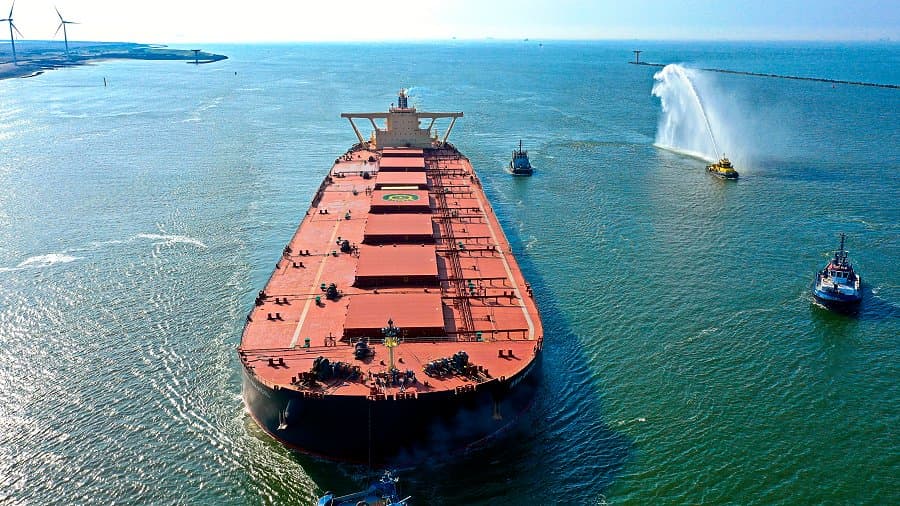There are no comments on this post yet
Japan’s Maritime Giants: A 30-Year Odyssey of Innovation and Power

Japan’s shipbuilding industry has long been a cornerstone of global maritime commerce, producing some of the world’s most formidable and technologically advanced vessels. Over the past three decades, Japanese shipyards have not only maintained their legacy but have also redefined the scale and sophistication of maritime engineering. Here’s a curated look at the most significant ships built in Japan since the mid-1990s, highlighting the trends, technological advancements, and fascinating facts that have shaped this era.
⚓ The Titans of the Sea: Japan's Largest Ships Since 1995
1. NSU Brazil
Type: Very Large Ore Carrier (VLOC)
Built: 2020 by Japan Marine United (Ariake Yard)
Dimensions: 361 m length × 65 m beam
Deadweight Tonnage: 399,821 tons
Flag: Liberia
Operator: Selenite Line S.A.
Highlights: The NSU Brazil is one of the largest ore carriers globally, purpose-built to transport massive quantities of iron ore. Her design incorporates advanced environmental technologies, including exhaust gas cleaning systems and compliance with international safety and environmental standards.
2. Seawise Giant (later Jahre Viking, Mont, Knock Nevis)
Type: Ultra Large Crude Carrier (ULCC)
Built: 1979 by Sumitomo Heavy Industries (Yokosuka)
Dimensions: 458.45 m length × 68.8 m beam
Deadweight Tonnage: 657,019 tons
Highlights: Holding the record for the heaviest self-propelled ship ever constructed, the Seawise Giant was so large that it couldn't navigate the Suez or Panama Canals. Its immense size and capacity made it a marvel of maritime engineering.
3. Asuka III
Type: Cruise Ship
Built: 2025 by Meyer Werft (Germany), delivered to Japan
Gross Tonnage: 52,265 GT
Highlights: As Japan's largest cruise ship, Asuka III marks a significant milestone in the nation's cruise industry. Notably, it is the first Japan-flagged passenger cruise ship in 34 years, reflecting a resurgence in domestic cruise shipbuilding.
🔍 Trends in Japanese Shipbuilding (1995–2025)
1. Shift from Military to Civilian Giants
While Japan's naval history boasts the massive battleships Yamato and Musashi, the post-World War II era saw a pivot towards civilian maritime power. The focus shifted to constructing large cargo carriers, tankers, and cruise ships, emphasizing economic strength and global trade dominance.
2. Technological Advancements
The past three decades have witnessed significant technological innovations, including:
Environmental Compliance: New vessels are designed to meet stringent international environmental standards, incorporating features like exhaust gas cleaning systems and ballast water treatment technologies.
Automation: Modern ships are increasingly automated, requiring smaller crews and enhancing operational efficiency.
Energy Efficiency: Emphasis on fuel efficiency and reduced emissions has led to the development of more sustainable vessels.
3. Strategic Military Exports
Japan's defense industry has gradually re-entered the global market. A notable example is the 2025 deal with Australia for the supply of Mogami-class frigates, marking Japan's most significant defense export since lifting its military export ban in 2014.
🌊 Fascinating Facts
Yamato's Legacy: The battleship Yamato, built during World War II, remains the heaviest and most powerfully armed battleship ever constructed, displacing nearly 72,000 tonnes and armed with nine 46 cm (18.1 in) main guns.
Seawise Giant's Record: Despite its retirement, the Seawise Giant holds the record for the heaviest self-propelled ship ever built, a testament to the engineering prowess of its time.
Asuka III's LNG Fueling: The Asuka III is equipped with dual-fuel LNG engines, reflecting Japan's commitment to reducing maritime emissions and promoting sustainable energy sources.
🚢 Conclusion
Japan's shipbuilding industry has evolved from constructing colossal warships to leading the world in building massive, technologically advanced civilian vessels. The trend towards larger, more efficient, and environmentally friendly ships continues to define Japan's maritime legacy. For seafarers and maritime enthusiasts, these developments highlight the dynamic nature of the industry and Japan's pivotal role in shaping the future of global shipping.
Inspired by Ocean World
Picture: NSU Brazil, Rotterdam, May 6th, 2022. Edwin van Werd